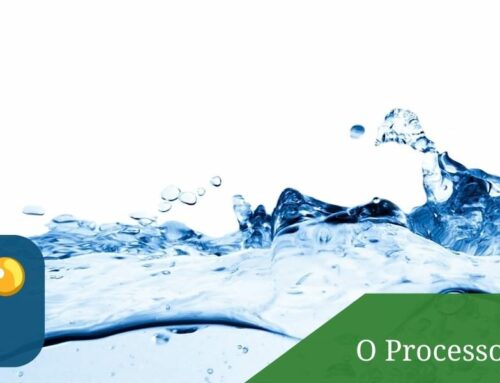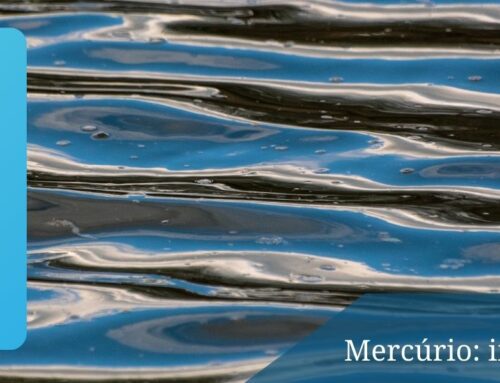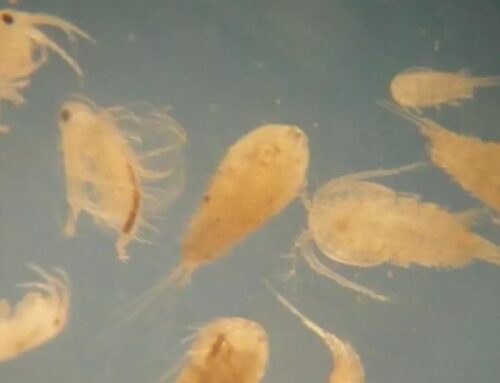By definition, osmosis is the displacement of solvent between two solution media with different concentrations, separated by a semipermeable membrane, where the solvent moves from the hypotonic medium toward the hypertonic medium, reaching the end when the two media are in chemical equilibrium of concentration.
Reverse osmosis occurs in the opposite direction of osmosis, i.e., the solvent moves from the more concentrated solution to the less concentrated one, thus isolating the solute.
Fig 1 – Reverse Osmosis Process
It is notorious that with each passing day we are experiencing a scarcity of fresh water in the form of easily-abstracted surface water. Another factor, besides scarcity, is the contamination of water sources, caused by discharges that often do not receive proper treatment or even any treatment at all. A reverse osmosis is a modern technology with wide application and great advantages in water purification, as well as in wastewater treatment to obtain reuse water, since it has a high capacity to remove chemical compounds that are difficult to be removed by conventional treatments
Scale and pre-treatment in reverse osmosis feed water
Reverse osmosis membranes are subject to fouling in the feed water of desalination systems, such as silica, calcium-based compounds, metal oxides, among other inorganic substances, as well as organic and biological material.
These materials, over time, will deposit on the membrane surface causing the loss of permeate volume, impairing the performance of the equipment, in addition to increasing the differential pressure between the feed side and the waste side, and can often cause physical damage to the membrane structure, leading to the loss of the membrane and the need for replacement.
Losing membranes due to clogging, is a cost that can be avoided, provided that the proper chemical cleaning processes are performed with the ideal periodicity.
It is important to reinforce the importance and necessity of pre-treating the feed water in order to reduce undesirable substances to the membranes, such as suspended solids, free chlorine, and bacteriological agents.
Dosages of chemicals such as sodium metabisulfite, biocide, and antifouling agent contribute greatly to the efficiency of the process, when properly dosed in the pre-treatment stage.
Microfiltration has shown satisfactory results as a pretreatment. It is a filtration process that uses filtering elements that can usually vary between 50 and 200 microns (each application must be studied and tested previously through a treatability study), preventing the osmosis from receiving this particulate load, further protecting the system.
It is important to report that the microfiltration filter elements are recovered through backwashing, which makes this process interesting and very economically viable.
Chemical cleaning of reverse osmosis membranes
Chemical cleaning is a process of removing substances from a material whose composition does not include those substances, through the use of chemicals, in order to restore the initial operating conditions with regard to permeate flow and percentage of rejection, with the positive effect of increasing the life of the membranes.
The choice of the chemical cleaning process to be employed must be determined by performing physicochemical and biological analyses, where it will be possible to know all the inorganic, organic, and biological contaminants.
Another method that can be used is membrane autopsy, using specific techniques that include the steps of:
- Visual inspection;
- Opening the element with a new visual inspection;
- Microbial count analysis;
- Determining the composition of the fouling layer;
- Scanning electron microscopic analysis;
- X-ray analysis.
Table 1 below lists the main membrane fouling agents:
| Cations | Anions |
| na + | Cl– |
| K + | OS 4 2- |
| Ca 2+ | NO 3 2- |
| Mg 2+ | PO 4 3- |
| NH 4+ | HCO 3 – |
| Fe 2+ | F– |
| Mn 4+ | CO 3 2- |
| SiO 2 |
| Biofouling |
Once the composition of the deposits is known, it is necessary to determine the cleaning agents to be used.
Usually more than one agent is used, since the deposits have different fouling characteristics (inorganic, organic, and biological).
Table 2 lists the main chemical cleaning agents employed.
| Cleaning agents | Characteristics of incrustations |
| Acidic solution | Soluble inorganic substances |
| Alkaline solution Detergent |
Organic substances (humic and fulvic acids)Colloids (silica, hydroxide, oxides)Bacteria, algae and fungi |
| Enzymes | Bacteria, algae and fungi |
The recirculation flow rate should be higher than the system’s operating flow rate, and the pressure should be lower. This makes the fouling more easily removable.
Regarding the concentration of the cleaning solutions, it is known that the higher the concentration, the greater the capacity for scale removal. However, solutions with a high concentration are more aggressive to membranes.
Higher temperatures tend to aid the fouling solubilization process, as they positively interfere with the kinetics of the reactions and the solubility conditions of the fouling agents. A temperature around 30-35°C has shown good results in cleaning efficiency.
Be very careful with much higher temperatures, as they can damage the physical structure of the membranes.
As a good preventive practice, it is recommended to consult the membrane manufacturer in cases of application of more aggressive cleaning processes or at high temperatures.
The contact time with the solution can vary according to the characteristics of the incrustations. More concentrated solutions require less contact time, but are more aggressive and harmful to the system.
The cleaning times generally applied vary between 25 and 40 minutes, but can be up to hours. All the more reason to be very familiar with the fouling present in the process.
Final considerations
With all of the above, there is no one chemical cleaning procedure that can be established as a standard.
Each system must be studied and known in order to apply the most appropriate and efficient chemical cleaning for each case.
It is very important to keep records of all chemical cleanings performed, as they will serve as a source of study and process improvement.
Over time, the cleaning procedure employed may not be the most efficient, as changes may occur in the system as well as in the characteristics of the feed water.
In processes where membrane filtration technology is applied, in this case Reverse Osmosis, it is of utmost importance to demand hours of design development that takes into account all the factors exposed here, such as a good pretreatment system, followed by an efficient chemical cleaning procedure.
The combinations of all these factors will contribute to an increase in the life of the equipment and consequently a reduction in operating costs and the cost of early membrane replacement.
EP Group, through EP Engenharia, can help you specify, manufacture, and supply the reverse osmosis system that is ideal for your application. Access the page and get to know all of our products and services.
Check out our page about Reverse Osmosis technology here!
Bibliographic references
https://www.infoescola.com/fisico-quimica/osmose-reversa/
Martins, N.C. Estudo de limpeza química em membranas de osmose inversa, 2012, TCC graduação em Engenharia Química, UFRGS, Porto Alegre.
Schneider, R.P. & Tomoyouki, M. (2001) Filter membranes for the treatment of water, sewage and reuse water, São Paulo.
Article by Odair José Krause (
LinkedIn
)





